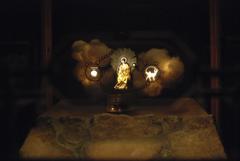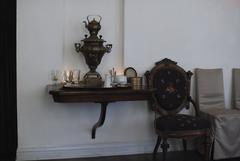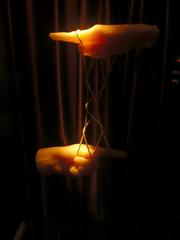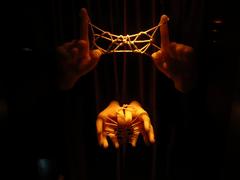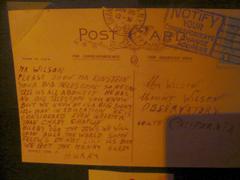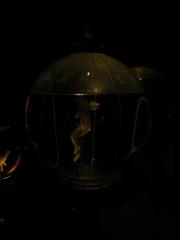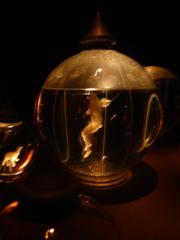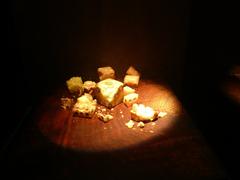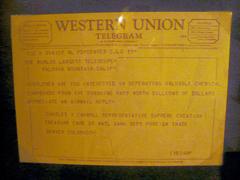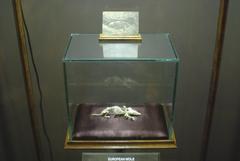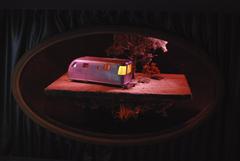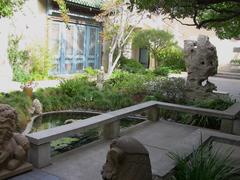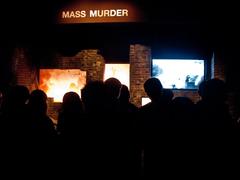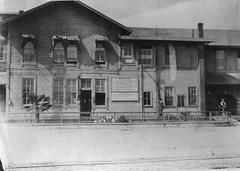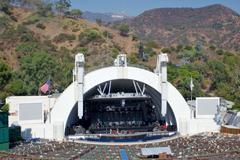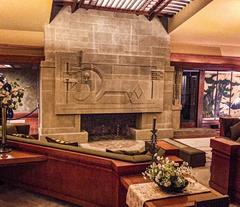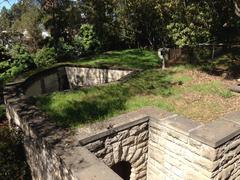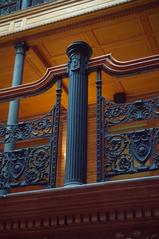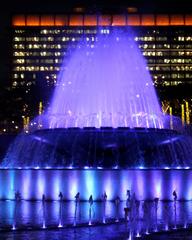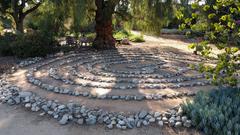
Comprehensive Guide to Visiting the Museum of Jurassic Technology, Los Angeles, United States
Date: 19/07/2024
Introduction
Nestled in the Palms district of Los Angeles, the Museum of Jurassic Technology (MJT) stands as a beacon of curiosity and intellectual exploration. Founded in 1988 by David Hildebrand Wilson and Diana Drake Wilson, the museum defies conventional expectations with its eclectic exhibits that blend fact and fiction. The MJT is not just a museum; it’s an experience designed to challenge your perceptions of reality and knowledge itself (Museum of Jurassic Technology).
The museum’s philosophy, described by David Wilson as “agnosticism towards knowledge,” invites visitors to question the reliability of information and the boundaries between science, art, and mythology. This unique approach has made the MJT a cultural landmark, attracting a diverse audience eager to explore its enigmatic exhibits (The New Yorker).
Table of Contents
- [History and Significance](#history-and-significancehistory-and-significance)
- [Origins and Founding](#origins-and-foundingorigins-and-founding)
- [Concept and Philosophy](#concept-and-philosophyconcept-and-philosophy)
- [Notable Exhibits](#notable-exhibitsnotable-exhibits)
- [The Microminiature Sculptures of Hagop Sandaldjian](#the-microminiature-sculptures-of-hagop-sandaldjianthe-microminiature-sculptures-of-hagop-sandaldjian)
- [The Garden of Eden on Wheels - Collections from Los Angeles Area Mobile Home and Trailer Parks](#the-garden-of-eden-on-wheels---collections-from-los-angeles-area-mobile-home-and-trailer-parksthe-garden-of-eden-on-wheels---collections-from-los-angeles-area-mobile-home-and-trailer-parks)
- [The Athanasius Kircher Collection](#the-athanasius-kircher-collectionthe-athanasius-kircher-collection)
- [The Delani/Sonnabend Halls](#the-delanisonnabend-hallsthe-delanisonnabend-halls)
- [The Horn of Mary Davis of Saugus](#the-horn-of-mary-davis-of-saugusthe-horn-of-mary-davis-of-saugus)
- [The Stink Ant of the Cameroon](#the-stink-ant-of-the-cameroonthe-stink-ant-of-the-cameroon)
- [The Tell the Bees - Belief, Knowledge, and Hypersymbolic Cognition](#the-tell-the-bees---belief-knowledge-and-hypersymbolic-cognitionthe-tell-the-bees---belief-knowledge-and-hypersymbolic-cognition)
- [The Garden of Health - The Pursuit of Medical Knowledge in the Middle Ages](#the-garden-of-health---the-pursuit-of-medical-knowledge-in-the-middle-agesthe-garden-of-health---the-pursuit-of-medical-knowledge-in-the-middle-ages)
- [The Lives of Perfect Creatures - Dogs of the Soviet Space Program](#the-lives-of-perfect-creatures---dogs-of-the-soviet-space-programthe-lives-of-perfect-creatures---dogs-of-the-soviet-space-program)
- [The Floral Stereoradiographs of Albert G. Richards](#the-floral-stereoradiographs-of-albert-g-richardsthe-floral-stereoradiographs-of-albert-g-richards)
- [Visitor Information](#visitor-informationvisitor-information)
- [Ticket Prices and Visiting Hours](#ticket-prices-and-visiting-hoursticket-prices-and-visiting-hours)
- [Travel Tips](#travel-tipstravel-tips)
- [Nearby Attractions](#nearby-attractionsnearby-attractions)
- [Accessibility](#accessibilityaccessibility)
- [Visitor Experience](#visitor-experiencevisitor-experience)
- [Educational Programs](#educational-programseducational-programs)
- [Influence on Contemporary Art and Museums](#influence-on-contemporary-art-and-museumsinfluence-on-contemporary-art-and-museums)
- [Frequently Asked Questions (FAQ)](#frequently-asked-questions-faqfrequently-asked-questions-faq)
- [Plan Your Visit](#plan-your-visitplan-your-visit)
History and Significance
Origins and Founding
The Museum of Jurassic Technology (MJT) was founded in 1988 by David Hildebrand Wilson and Diana Drake Wilson. The museum is located in the Palms district of Los Angeles, California. The founders envisioned a space that would challenge conventional perceptions of museums and the nature of knowledge itself. The museum’s name is a deliberate play on words, invoking the grandeur and mystery of the Jurassic period while juxtaposing it with the concept of technology, which is typically associated with modernity and progress.
Concept and Philosophy
The MJT is renowned for its unique and often perplexing exhibits that blend fact and fiction. The museum’s philosophy is rooted in the idea of “agnosticism towards knowledge,” a term coined by David Wilson. This approach encourages visitors to question the nature of reality and the reliability of information. The exhibits are designed to provoke curiosity and contemplation, blurring the lines between science, art, and mythology.
Notable Exhibits
The Microminiature Sculptures of Hagop Sandaldjian
One of the most famous exhibits at the MJT is the collection of microminiature sculptures by Armenian artist Hagop Sandaldjian. These sculptures are so small that they can only be viewed through a microscope. Sandaldjian’s works include a detailed sculpture of Pope John Paul II carved from a single strand of human hair and a representation of the Eiffel Tower placed inside the eye of a needle. The precision and intricacy of these sculptures highlight the extraordinary capabilities of human craftsmanship.
The Garden of Eden on Wheels - Collections from Los Angeles Area Mobile Home and Trailer Parks
This exhibit explores the culture and history of mobile home and trailer park communities in Los Angeles. It features a variety of artifacts, photographs, and personal stories that provide insight into the lives of residents. The exhibit challenges stereotypes and offers a nuanced perspective on a unique aspect of American life.
The Athanasius Kircher Collection
Athanasius Kircher was a 17th-century Jesuit scholar known for his wide-ranging interests and contributions to various fields, including geology, medicine, and Egyptology. The MJT’s collection includes replicas of Kircher’s inventions and illustrations, such as his famous “cat piano,” a musical instrument that purportedly used live cats to produce sound. This exhibit underscores the museum’s commitment to exploring the boundaries of knowledge and the interplay between science and imagination.
The Delani/Sonnabend Halls
The Delani/Sonnabend Halls feature a series of exhibits dedicated to the work of two fictional scientists, Geoffrey Sonnabend and Madelena Delani. Sonnabend’s theories on memory and perception are presented through a series of intricate models and diagrams, while Delani’s contributions to the field of neurophysiology are showcased through a collection of her personal effects and scientific instruments. This exhibit blurs the line between fact and fiction, encouraging visitors to question the nature of scientific knowledge and the ways in which it is constructed.
The Horn of Mary Davis of Saugus
This exhibit tells the story of Mary Davis, a woman from Saugus, Massachusetts, who purportedly grew a horn from her forehead in the 19th century. The horn, which is on display at the museum, is said to have been surgically removed and preserved. Accompanying the horn are various documents and illustrations that provide context for this unusual medical phenomenon. This exhibit explores the intersection of folklore, medicine, and the human fascination with the bizarre.
The Stink Ant of the Cameroon
The Stink Ant of the Cameroon exhibit delves into the life cycle of the Megaloponera foetens, a species of ant native to West Africa. The exhibit focuses on the ant’s unique relationship with a parasitic fungus that infects its brain, causing it to climb to a high point and attach itself to a leaf before dying. The fungus then sprouts from the ant’s head, releasing spores to infect other ants. This exhibit provides a detailed look at this fascinating example of parasitism in the natural world.
The Tell the Bees - Belief, Knowledge, and Hypersymbolic Cognition
This exhibit explores the ancient practice of “telling the bees,” a tradition in which beekeepers inform their bees of important events in their lives, such as births, deaths, and marriages. The exhibit includes a variety of artifacts related to beekeeping, as well as multimedia presentations that delve into the symbolic significance of bees in different cultures. This exhibit highlights the ways in which humans have historically sought to communicate with the natural world and imbue it with meaning.
The Garden of Health - The Pursuit of Medical Knowledge in the Middle Ages
The Garden of Health exhibit offers a glimpse into the world of medieval medicine, featuring a collection of medical texts, instruments, and illustrations from the period. The exhibit covers a range of topics, including herbal remedies, surgical techniques, and the role of astrology in medical practice. Visitors can learn about the ways in which medieval physicians sought to understand and treat illness, often blending scientific observation with mystical and religious beliefs.
The Lives of Perfect Creatures - Dogs of the Soviet Space Program
This exhibit pays tribute to the dogs that were sent into space by the Soviet Union during the early years of space exploration. The exhibit includes photographs, documents, and models related to the space dogs, as well as information about their training and the missions they participated in. This exhibit highlights the contributions of these animals to the advancement of space science and honors their role in human history.
The Floral Stereoradiographs of Albert G. Richards
Albert G. Richards was a pioneer in the field of dental radiography who also applied his expertise to the creation of stereoradiographs of flowers. These images, created using X-ray technology, reveal the intricate internal structures of various flowers in stunning detail. The exhibit features a selection of Richards’ stereoradiographs, along with information about his techniques and the scientific significance of his work. This exhibit showcases the beauty and complexity of the natural world as seen through the lens of advanced imaging technology.
Visitor Information
Ticket Prices and Visiting Hours
The Museum of Jurassic Technology is open Wednesday to Sunday from 2 PM to 6 PM. Ticket prices are $12 for adults, $10 for students and seniors, and free for children under 12. It is recommended to check the museum’s official website for any updates on visiting hours and ticket prices.
Travel Tips
The museum is located at 9341 Venice Boulevard, Los Angeles, CA 90034. Parking is available on the street and in nearby lots. The museum is wheelchair accessible, and visitors with special needs are encouraged to contact the museum in advance to arrange any necessary accommodations.
Nearby Attractions
While visiting the Museum of Jurassic Technology, consider exploring other nearby attractions in Los Angeles. The Getty Center, Los Angeles County Museum of Art (LACMA), and the Natural History Museum of Los Angeles County are all within a short drive and offer a diverse range of exhibits and experiences.
Visitor Experience
The MJT offers a unique and immersive visitor experience that is unlike any other museum. The dimly lit galleries and labyrinthine layout create an atmosphere of mystery and discovery. Visitors are encouraged to take their time exploring the exhibits and to engage with the material on a deeper level. The museum also offers guided tours and special events, such as lectures and performances, that further enrich the visitor experience.
Educational Programs
In addition to its exhibits, the MJT offers a variety of educational programs designed to engage and inspire learners of all ages. These programs include workshops, lectures, and hands-on activities that explore themes related to the museum’s exhibits. The MJT also collaborates with schools and community organizations to provide educational resources and opportunities for students.
Influence on Contemporary Art and Museums
The MJT has had a profound influence on contemporary art and museum practices. Its emphasis on the interplay between fact and fiction has inspired artists and curators to experiment with new forms of storytelling and exhibition design. The museum’s approach has also sparked discussions about the role of museums in society and the ways in which they can challenge and expand our understanding of the world.
Frequently Asked Questions (FAQ)
Q: What are the visiting hours for the Museum of Jurassic Technology?
A: The Museum of Jurassic Technology is open Wednesday to Sunday from 2 PM to 6 PM. It’s always a good idea to check their official website for any changes in hours.
Q: How much are the tickets for the Museum of Jurassic Technology?
A: Tickets are $12 for adults, $10 for students and seniors, and free for children under 12.
Q: Is the museum accessible for visitors with disabilities?
A: Yes, the museum is wheelchair accessible, and service animals are welcome.
Q: Are there any nearby attractions to visit?
A: Yes, nearby attractions include the Getty Center, Los Angeles County Museum of Art (LACMA), and the Natural History Museum of Los Angeles County.
Plan Your Visit
Consider downloading our mobile app Audiala for more travel tips and updates. Check out other related posts on our website, and follow us on social media for the latest news and events.
Conclusion
The Museum of Jurassic Technology stands as a testament to the power of curiosity and the endless possibilities of human imagination. Its unique blend of fact and fiction, science and art, challenges visitors to question their assumptions and to see the world in new and unexpected ways. As a cultural institution, the MJT continues to inspire and provoke, offering a space where the boundaries of knowledge are constantly being explored and redefined (The New York Times).
Visiting the MJT is an immersive experience that offers something for everyone—from the microminiature sculptures of Hagop Sandaldjian to the whimsical Garden of Eden on Wheels. The museum’s influence extends beyond its walls, impacting contemporary art and museum practices by encouraging new forms of storytelling and exhibition design. Whether you’re a local or a tourist, a visit to the Museum of Jurassic Technology promises an unforgettable journey into the mysterious and the marvelous (The New Yorker).
References
- Discover the Museum of Jurassic Technology - Hours, Tickets, and Unique Exhibits in Los Angeles. (n.d.). Retrieved from Museum of Jurassic Technology
- A Visit to the Museum of Jurassic Technology. (1995, October 29). The New York Times. Retrieved from The New York Times
- Mr. Wilson’s Cabinet of Wonder. (1995, November 6). The New Yorker. Retrieved from The New Yorker

